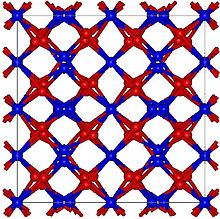Thallium(III) oxide

| |
| Names | |
|---|---|
| Other names
thallium trioxide, thallium sesquioxide
| |
| Identifiers | |
3D model (JSmol)
|
|
| ChemSpider | |
| ECHA InfoCard | 100.013.846 |
| EC Number |
|
PubChemCID
|
|
| UNII | |
CompTox Dashboard(EPA)
|
|
| |
| |
| Properties[1] | |
| Tl2O3 | |
| Molar mass | 456.76 g/mol |
| Appearance | dark brown solid |
| Density | 10.19 g/cm3,solid (22 °C) |
| Melting point | 717 °C (1,323 °F; 990 K) |
| Boiling point | 875 °C (1,607 °F; 1,148 K) (decomposes) |
| insoluble | |
| +76.0·10−6cm3/mol | |
| Structure | |
| Cubic,(Bixbyite)cI80[2] | |
| Ia3(No. 206) | |
| Hazards | |
| GHSlabelling:[3] | |
  
| |
| Danger | |
| H300+H330,H373,H411 | |
| P273,P301+P310+P330,P304+P340+P310,P314 | |
| NFPA 704(fire diamond) | |
| Lethal doseor concentration (LD, LC): | |
LD50(median dose)
|
44 mg/kg (oral, rat) |
Except where otherwise noted, data are given for materials in theirstandard state(at 25 °C [77 °F], 100 kPa).
| |
Thallium(III) oxide,also known asthallic oxide,is a chemical compound ofthalliumandoxygen.It occurs in nature as the rare mineralavicennite.[4]Its structure is related to that of Mn2O3which has abixbyitelike structure. Tl2O3is metallic with high conductivity and is a degenerate n-typesemiconductorwhich may have potential use insolar cells.[5]A method of producing Tl2O3byMOCVDis known.[6]Any practical use of thallium(III) oxide will always have to take account of thallium's poisonous nature. Contact withmoistureandacidsmay form poisonous thallium compounds.
Production
[edit]It is produced by the reaction of thallium with oxygen orhydrogen peroxidein an alkaline thallium(I) solution. Alternatively, it can be created by the oxidation ofthallium(I) nitrateby chlorine in an aqueouspotassium hydroxidesolution.[7]
References
[edit]- ^Weast, Robert C., ed. (1981).CRC Handbook of Chemistry and Physics(62nd ed.). Boca Raton, FL: CRC Press. p. B156.ISBN0-8493-0462-8..
- ^Otto H.H.; Baltrasch R.; Brandt H.J. (1993). "Further evidence for Tl3+ in Tl-based superconductors from improved bond strength parameters involving new structural data of cubic Tl2O3".Physica C.215(1–2): 205.doi:10.1016/0921-4534(93)90382-Z.
- ^GHS:Sigma-Aldrich 204617
- ^http://www.handbookofmineralogy.org/pdfs/avicennite.pdfHandbook of Mineralogy
- ^Phillips R. J.; Shane M. J.; Switzer J. A. (1989). "Electrochemical and photoelectrochemical deposition of Thallium(III) Oxide thin films".Journal of Materials Research.4(4): 923.Bibcode:1989JMatR...4..923P.doi:10.1557/JMR.1989.0923.S2CID96808351.
- ^D. Berry; R. T. Holm; R. L. Mowery; N. H. Turner & M. Fatemi (1991). "Thallium(III) Oxide by Organometallic Chemical Vapor Deposition".Chemistry of Materials.3(1): 72–77.doi:10.1021/cm00013a019.
- ^Georg Brauer; Handbuch der präparativen anorganischen Chemie, Band 2, S.884;ISBN3-432-87813-3(in German)

